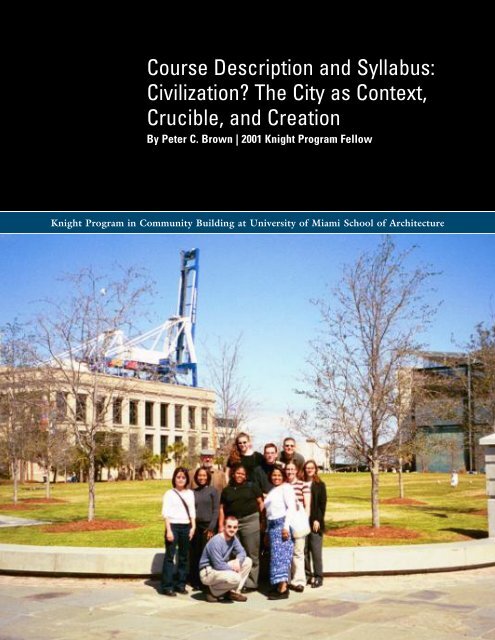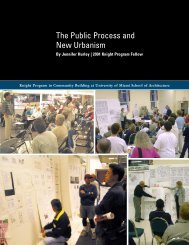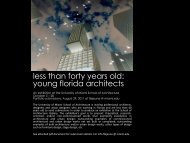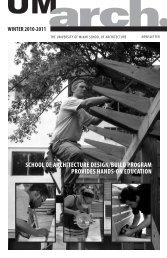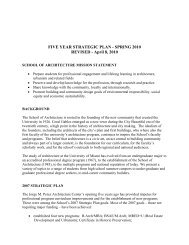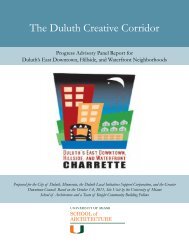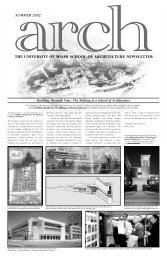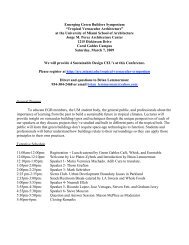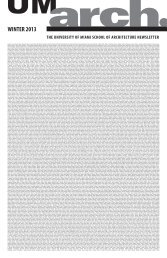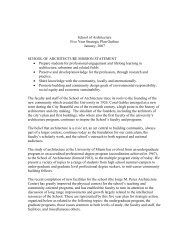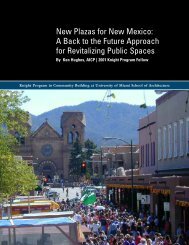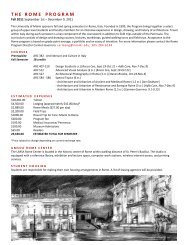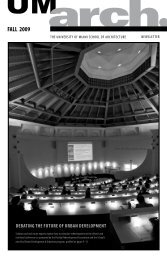Course Description and Syllabus: Civilization? - Knight Program in ...
Course Description and Syllabus: Civilization? - Knight Program in ...
Course Description and Syllabus: Civilization? - Knight Program in ...
- No tags were found...
You also want an ePaper? Increase the reach of your titles
YUMPU automatically turns print PDFs into web optimized ePapers that Google loves.
2<strong>Course</strong> <strong>Description</strong> <strong>and</strong> <strong>Syllabus</strong>: <strong>Civilization</strong>?The City as Context, Crucible, <strong>and</strong> CreationBy Peter C. Brown | 2001 <strong>Knight</strong> <strong>Program</strong> FellowBioPeter Brown is a professorof Philosophy <strong>and</strong>Interdiscipl<strong>in</strong>ary Studies<strong>and</strong> director of the MercerCenter for CommunityDevelopment at MercerUniversity <strong>in</strong> Macon, Georgia.AbstractAn underst<strong>and</strong><strong>in</strong>g of “the city” as a cont<strong>in</strong>gent human creation over time, asthe dom<strong>in</strong>ant contemporary social form, <strong>and</strong> as the crucible of civilized humancreativity is an under-appreciated aspect of a liberal education. College studentsare often as ignorant of the city as fish are of the l<strong>and</strong>. <strong>Civilization</strong>? The City asContext, Crucible, <strong>and</strong> Creation was offered as a senior general education courseat Mercer University <strong>in</strong> Macon, Georgia dur<strong>in</strong>g the 2002 Spr<strong>in</strong>g semester. Thecourse drew students from across the discipl<strong>in</strong>es of the arts <strong>and</strong> sciences.Students were <strong>in</strong>troduced to these “urban” cultural themes through works ofhistorical scholarship <strong>and</strong> social analysis, novels, films, <strong>and</strong> popular culture. Thecontemporary American city is at the crux of important issues of social justice,<strong>in</strong>come segregation, global competitiveness, environmental susta<strong>in</strong>ability, <strong>and</strong>regional governance. Us<strong>in</strong>g four Southern cities as case studies, which <strong>in</strong>cludedsite visits, the course required students to analyze the decay of the central cityover the past half century, the concentration of African-American <strong>and</strong> Hispanicpoverty <strong>in</strong> the central city, <strong>and</strong> the rise of suburban sprawl. Students were thenasked to <strong>in</strong>vestigate recent efforts at susta<strong>in</strong>able development <strong>and</strong> an urbanrenaissance. With a focus on revitalization <strong>in</strong>itiatives <strong>in</strong> Macon, Georgia, <strong>and</strong>Mercer University’s role <strong>in</strong> those <strong>in</strong>itiatives, students entered <strong>in</strong>to dialogue withcity leaders, university personnel, <strong>and</strong> neighborhood stakeholders to proposesteps toward solutions for the urban problems they identified. Emphasis throughoutwas placed on the passion, compassion, <strong>and</strong> vision of exceptional <strong>in</strong>dividualsfor whom rebuild<strong>in</strong>g community is a life work. The goals of this pilot course wereto <strong>in</strong>crease students’ appreciation of the role of the city <strong>in</strong> human culture, todeepen their underst<strong>and</strong><strong>in</strong>g of the challenges fac<strong>in</strong>g the American city <strong>in</strong> the 21stCentury, to model with them responsible citizenship as members of an urbancommunity, <strong>and</strong> to challenge them to identify their own vocations as contributorsto the matrix of urban civilization.
BROWN | THE CITY 4<strong>Course</strong> WorkThis is a highly participatory class. You must be active, creative, engaged, <strong>and</strong>committed to be successful. It also assumes that you already know most of what youneed to know to be successful <strong>in</strong> the class. The class requires you to apply yourexist<strong>in</strong>g skills <strong>and</strong> knowledge to produce a number of specific products, sometimes<strong>in</strong>dividually <strong>and</strong> sometimes <strong>in</strong> teams. One of the most important exist<strong>in</strong>g skillsyou must apply will be the ability to access new <strong>in</strong>formation <strong>and</strong> resources as neededto produce expected results. As much as possible, I want you to treat the class asif it were a work situation, <strong>in</strong>ternship, or extracurricular activity, i.e., you areresponsible for produc<strong>in</strong>g a high quality result <strong>in</strong> an area that matters to otherpeople to whom you are accountable. In short, the class is highly results oriented.We meet once a week. Every class session will <strong>in</strong>clude guest speakers <strong>and</strong>presenters. Most class sessions will require read<strong>in</strong>g 100-150 pages prior to the class.You will have an assignment due every class session. I expect you to be prepared<strong>in</strong>tellectually <strong>and</strong> motivationally to make class time count. Be prepared or be gone.Two absences from class may be excused (you must have a legitimate excuse), afterthat I will deduct 10 po<strong>in</strong>ts from your f<strong>in</strong>al grade for each absence.We have three site visits scheduled: Atlanta (one day), Charleston (three nights),<strong>and</strong> Memphis (three nights). I expect you to be able to go on at least two of thesesite visits. Your transportation, meal, <strong>and</strong> lodg<strong>in</strong>g expenses will be paid by theUniversity. You must commit your time. If you cannot arrange your schedule toaccommodate this requirement, please enroll <strong>in</strong> another Capstone. If you are unableto meet this requirement dur<strong>in</strong>g the course, 25 po<strong>in</strong>ts will be deducted from yourf<strong>in</strong>al grade for each of the two required site visits you fail to make.Grad<strong>in</strong>gThe course has two hundred po<strong>in</strong>ts that you can possibly earn.“A” = 180-200 po<strong>in</strong>ts“B+” = 170-179“B” = 160-169“C+” = 150-159“C” = 140-149“D” = 120-139
BROWN | THE CITY 5The f<strong>in</strong>al presentation, which is a class project, is worth 25% of your f<strong>in</strong>al grade(50 po<strong>in</strong>ts). Each specific weekly assignment is worth 10 po<strong>in</strong>ts. Late assignmentswill be penalized 2 po<strong>in</strong>ts <strong>and</strong> will not be accepted at all after noon of the follow<strong>in</strong>gMonday (-10 po<strong>in</strong>ts). Class participation is worth 10% of your f<strong>in</strong>al grade (20 po<strong>in</strong>ts).Class participation will be judged holistically by me on the basis of three factors:i. Evidence of excellent preparation for class, ii. Constructive responses to classdiscussion, <strong>and</strong> iii. Insights <strong>and</strong> critical questions contributed to discussion. Simplytalk<strong>in</strong>g a lot will not necessarily be rewarded with a high grade. You will receive amid-term <strong>and</strong> f<strong>in</strong>al class participation grade (10/10 po<strong>in</strong>ts).
BROWN | THE CITY 6<strong>Syllabus</strong>IA = Individual Assignment TA = Team Assignment CA = Class AssignmentDate Read<strong>in</strong>gs/Case Studies/Speakers Assignments1/10 <strong>Course</strong> Outl<strong>in</strong>e & <strong>Syllabus</strong> Form<strong>in</strong>g Teams1/17 Read<strong>in</strong>g: Lewis Mumford The City <strong>in</strong> History 1. IA: Def<strong>in</strong>e the CityCh 1-4 Case Study: The Ancient PolisSpeaker: Beth Stewart “Images of the City”1/24 Read<strong>in</strong>g: Listen<strong>in</strong>g <strong>and</strong> Learn<strong>in</strong>g: CommunityIndicator Profiles of <strong>Knight</strong> FoundationCommunities; Pre-Charrette Town Paper: Beall’s HillCase Study: Macon — Beall’s Hill: A ComprehensiveCommunity InitiativePanel: Tanzer<strong>in</strong>a Kennebrew,Stan S<strong>in</strong>gleton, Charidy V<strong>in</strong>son, Charles Watts,Lawrence Williamson, Harold Wilson1/31 Read<strong>in</strong>g: Jane Jacobs The Death <strong>and</strong> Life ofGreat American Cities Ch 1-6Case Study: Macon —The Built HeritagePanel: Jordan Jelks & Gene Dunwody2/7 Read<strong>in</strong>g: Jacobs Ch 7-12; The New Yorker(January 21, 2002)Case Study: Manhattan as the Locus ofWestern <strong>Civilization</strong>Speaker: Mike Cass2/14 Read<strong>in</strong>g: Mumford Ch 14-15; Booth Tark<strong>in</strong>gton/Orson Wells The Magnificent AmbersonsCase Study: The Industrialization of IndianapolisSpeaker: Jay Stege2. TA: What does the <strong>Knight</strong>Foundation Community IndicatorProfile tells us about Macon?(700-800 words for publication <strong>in</strong>Macon Telegraph)3. TA: Place Mak<strong>in</strong>g: The FifteenMost Dist<strong>in</strong>ctive Design Featuresof Macon, Georgia (Powerpo<strong>in</strong>t)4. IA: What is the city accord<strong>in</strong>g toThe New Yorker?5. IA: Who is the hero of TheMagnificent Ambersons?
BROWN | THE CITY 7Date Read<strong>in</strong>gs/Case Studies/Speakers Assignments2/21 Read<strong>in</strong>g: Robert Lupton Return Flight;James Howard Kunstler The City <strong>in</strong> M<strong>in</strong>d“Atlanta: Does the Edge City Have a Future?”Case Study: Atlanta — Gentrification <strong>in</strong> Summerhill(site visit TH 8 AM – 6 PM)Speakers: Robert Lupton, Neil Shorthouse,Ellen Dunham-Jones2/28 Read<strong>in</strong>g: Jacobs Ch 13-16; William Julius WilsonThe Truly Disadvantaged Ch 1-4Case Study: Macon — Borders & SlumsSpeaker: R<strong>and</strong>y Harshbarger3/7-10 Case Study: Charleston — Preservation as aModel (site visit Th 1 PM - Su 1 PM)Speaker: Tim Keane6. IA: Identify three criticalquestions for Robert Lupton.7. TA: Offer a critique of MercerUniversity’s relation to the neighborhoodsof which it is part <strong>and</strong>recommendations for strengthen<strong>in</strong>git. (Draft it as a two-page memoto President Godsey)8. CA: Outl<strong>in</strong>e of F<strong>in</strong>al Presentation3/14 Spr<strong>in</strong>g Break3/21 Read<strong>in</strong>g: Wilson Ch 5-7; Jacobs Ch 17-22;Harry Wexler “HOPE VI: Market Means/Public Ends”Case Study: Macon — Oglethorpe Homes<strong>and</strong> HOPE VIPanel: Chester Wheeler, John Hiscox, Harry Wexler3/28 Good Friday holiday4/4 Read<strong>in</strong>g: Mumford Ch 16-18;Andres Duany, Elizabeth Plater-Zyberk, &Jeff Speck Suburban Nation Ch 1-7Case Study: Macon — The Case for the Inner-CitySpeaker: R<strong>and</strong>y Harshbarger4/11-14 Case Study: Memphis — The University as a Catalystfor Revitalization (site visit Th 7 AM – Su 6 PM)Speaker: David Cox4/18 Read<strong>in</strong>g: Duany et. al. Ch 8-11;Post-Charrette Town Paper: Beall’s HillCase Study: Macon — Beall’s Hill as Pilot Projectfor the CityPanel: Kennebrew, S<strong>in</strong>gleton, V<strong>in</strong>son9. IA: What are the primary causesof <strong>and</strong> possible cures for concentratedurban poverty?10. IA: Analyze Charleston throughJane Jacobs’ eyes (Bulletedoutl<strong>in</strong>e — due by 12 noon 3/28)11. TA: The top ten reasons(<strong>in</strong> reverse order) why Americanschoose to live <strong>in</strong> the suburbs.12. IA: Insights ga<strong>in</strong>ed, reformationsbegun, <strong>and</strong> convictions strengthened<strong>in</strong> the context of this course.13. TA: What design, policy, <strong>and</strong>management <strong>in</strong>itiatives arethe keys to the revitalizationof Beall’s Hill?4/23 (T) 14. CA: Draft F<strong>in</strong>al Presentation5/7 (T) F<strong>in</strong>al Presentation (7 PM)


